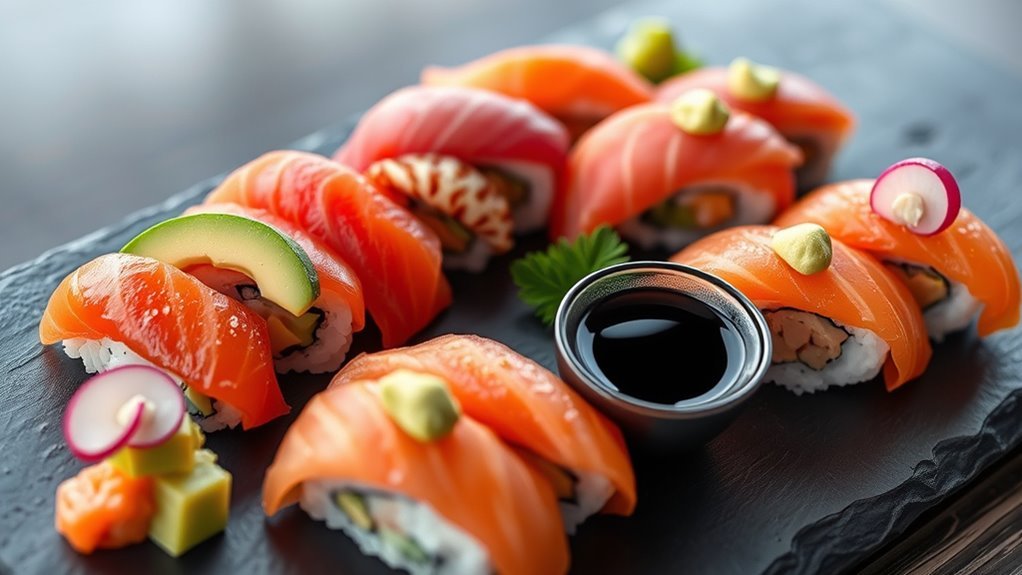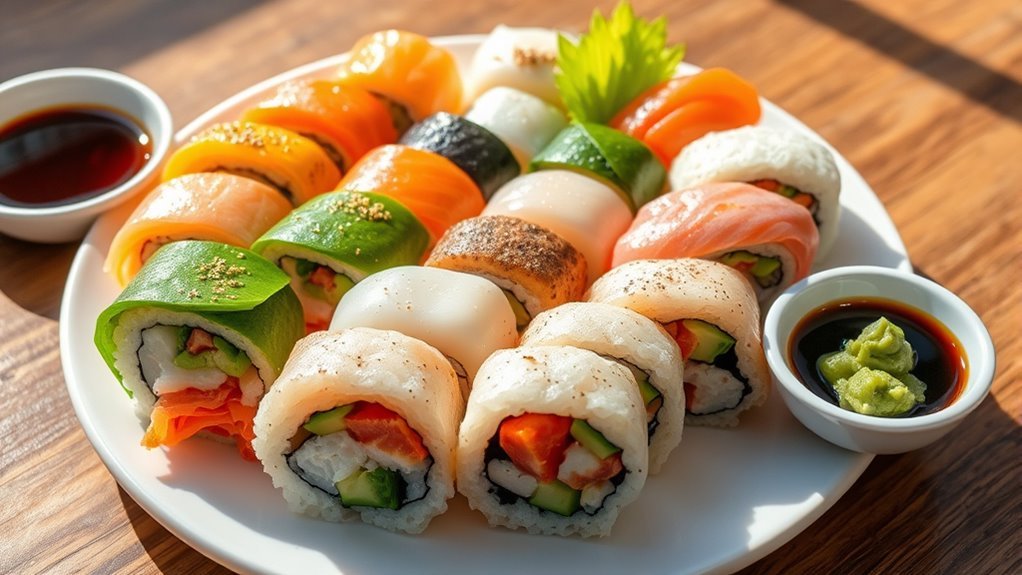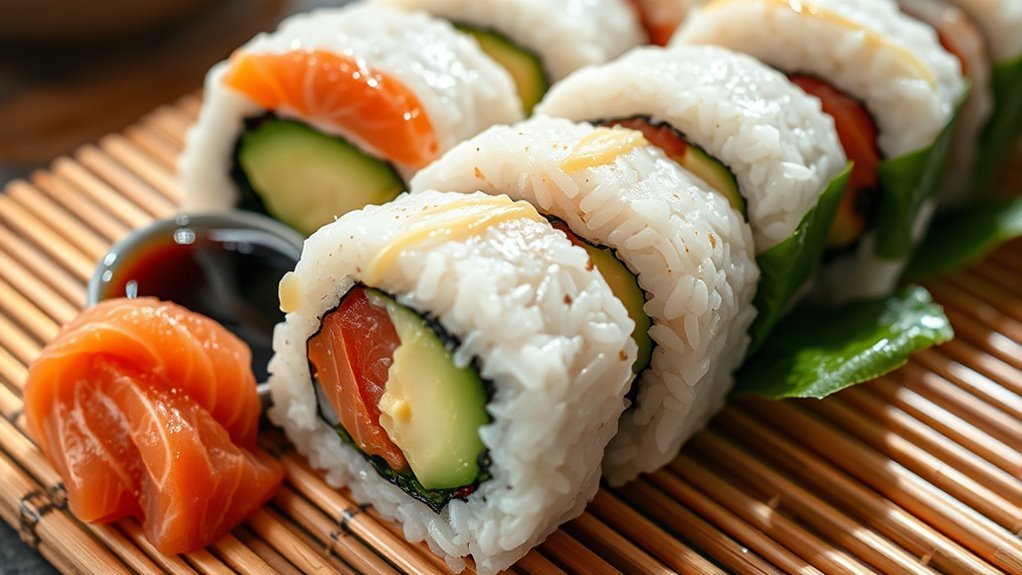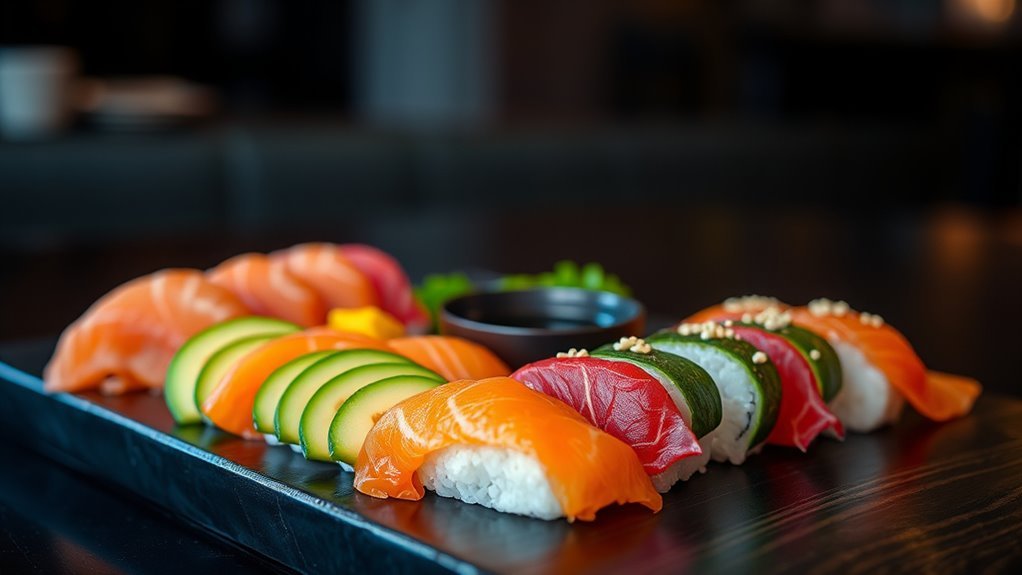Sushi isn’t inherently keto-friendly due to its high carb content, mainly from the rice. Traditional sushi rice can contain around 30 grams of carbohydrates per serving, which can hinder your keto goals. However, you can enjoy sushi by opting for alternatives like sashimi, cucumber rolls, or cauliflower rice rolls. These options provide protein and keep carbs low. If you want to explore more creative sushi choices and tips for dining out, there are plenty of ideas to contemplate!
Understanding the Keto Diet

When considering whether sushi fits into your keto lifestyle, it is vital to first understand the fundamentals of the keto diet. The keto principles emphasize low carbohydrate intake, typically around 20-50 grams per day, which encourages your body to enter a state of ketosis. This means it burns fat for fuel instead of glucose. Understanding your dietary restrictions is essential; you’ll want to avoid high-carb ingredients like rice or sugary sauces commonly found in sushi. Instead, focus on low-carb options, such as sashimi or sushi rolls wrapped in vegetables. By staying informed about what aligns with your keto goals, you can enjoy the freedom to explore various culinary experiences while adhering to your dietary needs. Additionally, being aware of the macronutrient ratios is crucial for maintaining ketosis and optimizing your diet.
Traditional Sushi Ingredients

When you think about traditional sushi, the primary ingredient that comes to mind is rice, which poses challenges for those following a keto diet due to its high carbohydrate content. Additionally, while sushi often features a variety of protein sources like fish and seafood, understanding their nutritional profiles can help you make better choices. Let’s explore how these ingredients impact the keto suitability of sushi.
Rice Composition Challenges
Although sushi can be a delicious treat, the traditional rice used in its preparation presents considerable challenges for those following a keto diet. Regular sushi rice is high in carbohydrates, which can kick you out of ketosis. However, you don’t have to miss out entirely. There are various rice alternatives that can suit your keto lifestyle, such as cauliflower rice or shirataki rice. These options can mimic the texture you love while considerably reducing the carb count. Additionally, exploring sushi variations that use these alternatives can keep your meals exciting and flavorful. By being mindful of your choices, you can still enjoy sushi without compromising your dietary goals. Embrace creativity in your sushi-making to maintain that freedom you cherish! Including alternatives like cauliflower rice allows you to enjoy sushi while keeping carbohydrate content in check.
Common Protein Sources
Exploring the protein sources in sushi can enhance your culinary experience while adhering to a keto diet. Sushi proteins primarily come from seafood varieties, such as salmon, tuna, and shrimp, which are rich in healthy fats and essential nutrients. If you’re looking for alternatives, meat choices like chicken or beef can also be incorporated into your rolls. For those who prefer vegetarian options, tofu offers a great source of protein with minimal carbs. Additionally, plant proteins, such as edamame, can add variety to your meal. By focusing on these protein sources, you can enjoy delicious sushi while keeping your keto goals intact. Just be mindful of any high-carb accompaniments you might encounter! To ensure you stay on track, understanding net carbs calculation will help you make informed choices about your sushi ingredients.
Carbohydrate Content in Sushi Rice

While sushi is often celebrated for its fresh ingredients and unique flavors, the carbohydrate content in sushi rice can raise concerns for those following a ketogenic diet. Sushi rice is typically seasoned and has higher carbohydrate levels compared to other options. Here are some key points to take into account:
Sushi’s fresh flavors come with a carb concern, especially for those on a ketogenic diet.
- A single serving of sushi rice contains about 30 grams of carbohydrates.
- The sticky texture of sushi rice comes from the short-grain variety, which enhances its carb content.
- Most sushi rolls contain additional ingredients that can contribute to overall carbs.
- Even small amounts can add up quickly in a low-carb diet.
- It’s important to be mindful of portion sizes when enjoying sushi.
- Carbohydrate types significantly influence how sushi can fit into a keto lifestyle.
If you’re watching your carb intake, understanding these levels can help you make informed choices.
Keto-Friendly Sushi Alternatives
If you’re looking for keto-friendly sushi alternatives, consider cauliflower rice rolls, which replace traditional sushi rice with a low-carb option. Seaweed salads can also be a great addition, offering healthy fats and fiber without the extra carbs. These choices not only fit your dietary needs but can still satisfy your sushi cravings. Additionally, incorporating healthy fats into your sushi alternatives can further enhance satiety and support your overall health on the keto diet.
Cauliflower Rice Rolls
Cauliflower rice rolls offer a delicious and satisfying alternative for those following a keto diet who crave sushi. By using cauliflower as a rice substitute, you not only cut carbs but also gain numerous cauliflower benefits, such as increased fiber and essential vitamins.
Consider these ideas for your cauliflower rice rolls:
- Fresh veggies like cucumber and bell pepper
- Creamy avocado for healthy fats
- Protein options like crab, shrimp, or grilled chicken
- Flavorful sauces like soy or sriracha
- A sprinkle of sesame seeds for crunch
These rolls provide a fun, versatile way to enjoy sushi while keeping your carb intake low. With a little creativity, you can whip up a keto-friendly feast that satisfies your sushi cravings! Additionally, incorporating low-carb vegetables into your rolls ensures you meet your nutritional needs while enjoying a balanced meal.
Seaweed Salad Options
Seaweed salad can be an excellent addition to your keto-friendly sushi alternatives, as it’s low in carbs and packed with nutrients. Rich in vitamins and minerals, seaweed offers numerous health benefits, including boosting your metabolism and supporting gut health. You’ll find that many seaweed salad recipes are easy to prepare, often featuring ingredients like sesame oil, vinegar, and vegetables, all of which maintain a low carb count. By opting for seaweed salads instead of traditional sushi rolls, you can enjoy a flavorful dish without sacrificing your keto goals. Additionally, incorporating kimchi’s low carbohydrate content into your meals can provide a tangy flavor while keeping your carb intake in check. So next time you crave sushi, consider whipping up a revitalizing seaweed salad as a satisfying and nutritious alternative that aligns perfectly with your lifestyle.
Low-Carb Sushi Rolls to Try
While traditional sushi often features rice, you can still enjoy delicious rolls that fit a low-carb lifestyle. By opting for low carb ingredients, you can create sushi alternatives that satisfy your cravings without the carbs. Here are some tasty options you might want to try:
Enjoy sushi without the carbs by using creative low-carb ingredients for delicious rolls that satisfy your cravings.
- Cucumber Rolls: Use thinly sliced cucumber as a wrap instead of rice.
- Cauliflower Rice Rolls: Substitute rice with cauliflower rice for a twist.
- Avocado Rolls: Fill the roll with creamy avocado and your choice of protein.
- Salmon Skin Rolls: Crisp salmon skin can add a crunchy, flavorful element.
- Zucchini Noodle Rolls: Use spiralized zucchini to create a fresh take on sushi.
Incorporating low-carb leafy greens can enhance the nutritional value of your sushi rolls.
These low-carb sushi rolls let you indulge without guilt!
Sushi Sashimi: A Safe Bet
If you’re looking for a keto-friendly option at a sushi restaurant, sashimi is often a safe bet. This dish, which consists of thinly sliced raw fish or seafood, boasts numerous sashimi benefits. Not only is it rich in high-quality protein, but it’s also low in carbs, making it an ideal choice for those following a ketogenic diet. With options like salmon, tuna, and mackerel, you can enjoy a variety of flavors while keeping your carb intake minimal. Plus, sashimi is usually served with soy sauce or wasabi, which can enhance the taste without adding significant carbs. Additionally, incorporating low-carb options like sashimi into your meals can help you stay within your dietary limits. So, next time you’re out for sushi, remember that sashimi can easily fit into your low carb options while satisfying your cravings.
Creating Your Own Keto Sushi at Home
Creating your own keto sushi at home can be a fun and satisfying way to enjoy this beloved cuisine while sticking to your dietary goals. With some simple sushi preparation techniques and ingredient substitutions, you can create delicious low-carb rolls. Here are a few tips to get you started:
- Use cauliflower rice instead of traditional sushi rice.
- Opt for fresh vegetables like cucumber, avocado, and bell peppers.
- Choose protein-rich fillings, such as shrimp, crab, or tofu.
- Wrap your sushi in nori or lettuce leaves instead of rice paper.
- Experiment with low-sugar sauces or make your own.
- Incorporate leafy greens like spinach or arugula for added nutrients and flavor.
Dining Out: Making Smart Sushi Choices
When dining out, making smart sushi choices can help you enjoy your meal without compromising your keto lifestyle. Start by opting for sashimi or nigiri with minimal rice. You might also consider rolls wrapped in cucumber instead of rice, which keeps carbs low. Pay attention to sauces; they can be loaded with sugars. Using sushi etiquette, remember to ask your server for recommendations that align with your dietary needs. Dining strategies like sharing a few small plates can also help you sample various flavors while managing portion sizes. Don’t hesitate to customize your order; many sushi chefs appreciate when diners express their preferences. By making informed choices, you can savor your sushi experience while staying true to your keto goals.
Frequently Asked Questions
Can I Eat Sushi While on a Strict Keto Diet?
You can enjoy sushi while on a strict keto diet, but you’ll need to choose wisely. Look for low carb rolls, like those wrapped in cucumber instead of rice. Sushi alternatives, such as sashimi or poke bowls without rice, are also great options. Always check for added sugars in sauces, as they can sneak in extra carbs. With mindful choices, you can satisfy your sushi cravings while staying true to your keto goals.
What Are the Best Sushi Toppings for Keto?
Think of your sushi as a canvas, and the toppings as the vibrant colors that bring it to life. For keto sushi, low carb toppings like avocado, cucumber, and sashimi are your best friends. You can also enjoy cream cheese or spicy mayo in moderation. Opt for seaweed wraps instead of rice, and you’ll create a delicious meal that fits your lifestyle while keeping your carb count low. Enjoy the freedom of flavorful choices!
Is Wasabi Keto-Friendly?
Yes, wasabi is keto-friendly! It’s low in calories and carbs, making it a great addition to your meals. Wasabi nutrition typically includes beneficial compounds like antioxidants, but be mindful of portions, as it can be spicy. If you’re looking for alternatives, consider horseradish or even mustard, which can provide similar heat without compromising your keto goals. Enjoy adding flavor while staying within your dietary preferences!
How Often Can I Eat Sushi on Keto?
You can enjoy sushi on a keto diet, but it’s all about balance. Ironically, the more you crave those rolls, the less often you should indulge—aim for once a week. Stick to options with minimal rice or choose sashimi for a true keto feast. This way, you keep your sushi frequency in check while maintaining your keto balance. Remember, it’s about satisfying your cravings without derailing your goals! Enjoy the freedom of choice!
Are There Any Sushi Sauces That Are Keto-Approved?
Yes, there are keto-friendly sauces you can enjoy with sushi. Look for options like soy sauce or tamari, which are low in carbs. You might also consider sushi sauce alternatives like wasabi or a homemade spicy mayo made with avocado oil and a sugar-free mayo base. Just be cautious with sauces that contain added sugars, as they can quickly increase your carb intake. Enjoy experimenting with these options while keeping your keto goals in mind!


